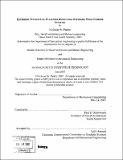| dc.contributor.advisor | Paul D. Sclavounos. | en_US |
| dc.contributor.author | Parker, Nicholas W. (Nicholas William) | en_US |
| dc.contributor.other | Massachusetts Institute of Technology. Dept. of Mechanical Engineering. | en_US |
| dc.date.accessioned | 2008-02-27T22:14:56Z | |
| dc.date.available | 2008-02-27T22:14:56Z | |
| dc.date.copyright | 2007 | en_US |
| dc.date.issued | 2007 | en_US |
| dc.identifier.uri | http://hdl.handle.net/1721.1/40369 | |
| dc.description | Thesis (S.M. in Naval Architecture and Marine Engineering and Mechanical Engineering)--Massachusetts Institute of Technology, Dept. of Mechanical Engineering, 2007. | en_US |
| dc.description | Includes bibliographical references (p. 85). | en_US |
| dc.description.abstract | The rise of reliable wind energy application has become a primary alternative to conventional fossil fuel power plants in the United States and around the world. The feasibility of building large scale wind farms has become increasingly dependent on location. The ideal locations require placement in desolate areas with limited or no visibility from surrounding communities, and with the presence of a consistent wind-enriched climate. Deployments of wind turbines in an offshore environment where water depths exceed 30 meters satisfy these requirements. Studies have shown that existing offshore wind turbine systems are limited to shallower coastal waters by the cost of constructing and installing the support structures. This thesis provides a continued parametric analysis of floating platforms for the support of offshore wind turbine systems. In particular, the Tension Leg Platform design will be optimized. Optimization is achieved through the coupling of wave-body interaction theory for the platform along with the aerodynamic performance of a 5-Megawatt wind turbine in the frequency domain. The study provides comparisons over a variety of initial tether tensions and the dynamic response and performance of the platform in several sea states. | en_US |
| dc.description.abstract | (cont.) Statistical quantities are evaluated to ensure these tensions provide adequate forces in storms for various sea states where the significant wave heights can be expected to be 5 meters or greater. The Tension Leg Platform is substantially resistant to heave, pitch and roll motions; therefore, methods of damping the larger surge and sway responses are presented and discussed. | en_US |
| dc.description.statementofresponsibility | by Nicholas W. Parker. | en_US |
| dc.format.extent | 85 p. | en_US |
| dc.language.iso | eng | en_US |
| dc.publisher | Massachusetts Institute of Technology | en_US |
| dc.rights | M.I.T. theses are protected by copyright. They may be viewed from this source for any purpose, but reproduction or distribution in any format is prohibited without written permission. See provided URL for inquiries about permission. | en_US |
| dc.rights.uri | http://dspace.mit.edu/handle/1721.1/7582 | |
| dc.subject | Mechanical Engineering. | en_US |
| dc.title | Extended tension leg platform design for offshore wind turbine systems | en_US |
| dc.type | Thesis | en_US |
| dc.description.degree | S.M.in Naval Architecture and Marine Engineering and Mechanical Engineering | en_US |
| dc.contributor.department | Massachusetts Institute of Technology. Department of Mechanical Engineering | |
| dc.identifier.oclc | 190862366 | en_US |
